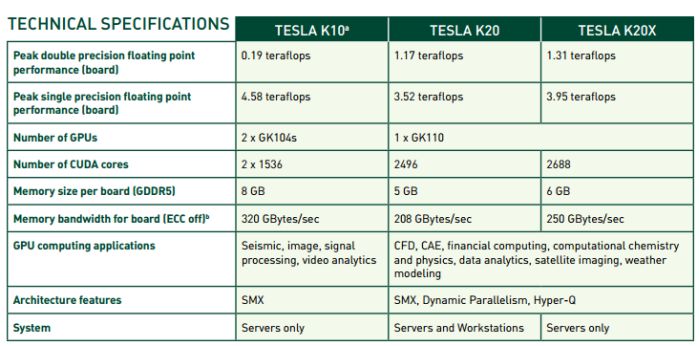
If you’re a bit lost with latest NVIDIA’s computing GPUs, here is a quick overview of the recent Kepler-based boards focused on high performance computing: Tesla K10 (two GK104 GPUs), Tesla K20 (single GK110 GPU) and Tesla K20X (single GK110 GPU). Now if you look for the ultimate TFLOP board, the freshly announced
FirePro S10000 should interest you: 5.92TFLOPS for the S10000 against 4.58TFLOPS for the K10…
Tesla K10 GPU Accelerator – Optimized for single precision applications, the Tesla K10 includes two ultra-efficient GK104 Kepler GPUs to deliver high throughput. It delivers up to 2x the performance for single precision applications compared to the previous generation Tesla M2090 GPU in the same power envelope. With an aggregate performance of 4.58 teraflop peak single precision and 320 gigabytes per second memory bandwidth for both GPUs put together, the Tesla K10 is optimized for computations in seismic, signal image processing, and video analytics.
Tesla K20 and K20X GPU Accelerators – Designed to be the performance leader in double precision applications and the broader supercomputing market, the Tesla K20 and K20X GPU Accelerators deliver 10x the performance of a single CPU2. Tesla K20 and K20X both feature a single GK110 Kepler GPU that includes the Dynamic Parallelism and Hyper-Q features. With more than one teraflop peak double precision performance, these GPU accelerators are ideal for the most aggressive high-performance computing workloads including climate and weather modeling, CFD, CAE, computational physics, biochemistry
simulations, and computational finance.
Source: Geeks3D forum
I wonder if the K20 will run GL under Linux like the other CUDA cards?
It would be interesting to see how much faster GK110 would have been for gaming over GK104.
nVidia’s Tesla line is toast. Xeon Phi is out, cheaper, easy to migrate, more flexible. GPGPU is dead!
DrBalthar the retard must be reading Always Inaccurate again.
Xeon Phi, slower and consumes more power even on 22nm for lower performance.
Kepler doesn’t understand that performance numbers on paper don’t translate in real application performance numbers.
Oak Ridge’s Titan is paper. Not sure if stupid AMD fanbay or stupid AMD fanboy.
@Anon – well see what’s linpack result of that supercomputer and then think – what is the percentage of real life performance vs peak performance. Well? Is it 100%? Nope. Some 70-80 top.
NVIDIA has strong development background which supports their GPUs. CUDA is really strong platform developing over several years. Many people don’t know imagine it, especially people who never work in IT world and SW development. For now Xeon Phi is something new and nobody know what future is waiting for it. Yes Intel is strong and can push it’s product but it’s not so easy. It can takes some years. Maybe in the future Intel solution will be the best, but we don’t know what will happen. For now and near future NVIDIA doesn’t have to worry about that. This company has strong position and nobody can predict that their solution will fail. Maybe DrBaltar this is only just your dream for now.
It would be interesting to see how much faster GK110 would have been for gaming over GK104.
should be the same performance as a sli of 660 ti or even a sli of 670’s
think my 690 gtx should be faster (clocked to 1200 mhz on the gpu’s and gddr5 clocked 7ghz effective in my case)
But obviously this chip wasn’t design for gaming purpose but for grid computing purpose